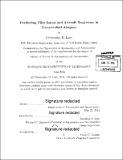Predicting pilot intent and aircraft trajectory in uncontrolled airspace
Author(s)
Lowe, Christopher D., S.M. (Christopher David). Massachusetts Institute of Technology
DownloadFull printable version (13.95Mb)
Other Contributors
Massachusetts Institute of Technology. Department of Aeronautics and Astronautics.
Advisor
Jonathon P. How.
Terms of use
Metadata
Show full item recordAbstract
The ability to predict the likely trajectory is a key element of safely integrating Unmanned Aerial Systems (UAS) in the National Airspace System (NAS). A particularly challenging environment is in the vicinity of uncontrolled airports, where the route the pilot plans to follow is not available. Existing trajectory prediction methods that rely on propagating the current velocity of the aircraft are not well suited to long-term prediction of pilot behavior in this environment. This thesis proposes a new probabilistic trajectory prediction method within a hierarchical pilot behavior framework that extends the model proposed by Liao et al. [41]. In general trajectories are predicted using only low-level measurements of aircraft state, with no a priori of pilot intent. Trajectories are drawn from a novel navigation model that represents aircraft motion as a Hidden Markov Model in which the state space is composed of possible mode change points. A likelihood function inspired by the approach of Yepes et al. [63] is used to map current aircraft state in continuous space to a high probability discrete sequence of mode change points. An unsupervised learning process is used to identify both the structure and parameters of the navigation model. This approach addresses the weakness of previous Markov model-based approaches that require a fine discretization of the Cartesian state space by representing only features where a branch in aircraft trajectory may occur. Using the proposed likelihood function, learning can be achieved without requiring training data spanning the entire state space. This approach also allows very computationally efficient prediction over a long prediction window to be performed in real time. The resulting long-term trajectory predictions are shown to be far more accurate than can be achieved with other methods that do not take into account intent, particularly in the challenging uncontrolled airport environment. These predictions can be used by UAS to safely plan trajectories through uncontrolled airspace in the NAS.
Description
Thesis: S.M., Massachusetts Institute of Technology, Department of Aeronautics and Astronautics, 2014. Cataloged from PDF version of thesis. Includes bibliographical references (pages 161-165).
Date issued
2014Department
Massachusetts Institute of Technology. Department of Aeronautics and AstronauticsPublisher
Massachusetts Institute of Technology
Keywords
Aeronautics and Astronautics.